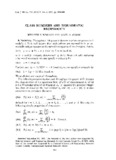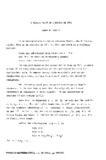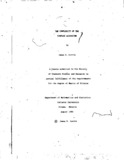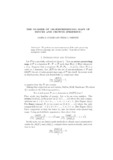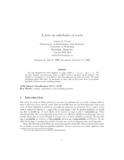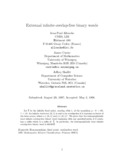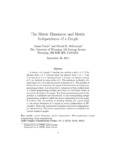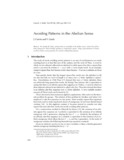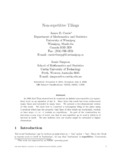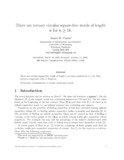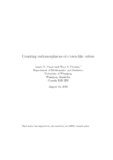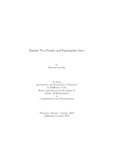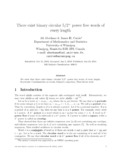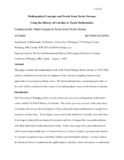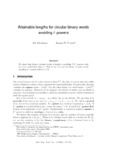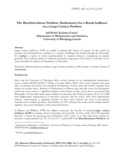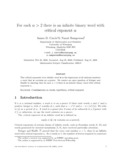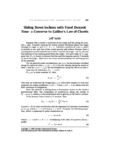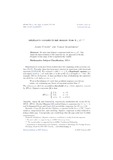Browsing Department of Mathematics and Statistics by Issue Date
Now showing items 1-20 of 56
-
Class Numbers and Biquadratic Reciprocity
(Cambridge University Press, 1982) -
A direct proof of a result of Thue
(Utilitas Mathematica, 1984) -
The Complexity of the Simplex Algorithm
(Carleton UniversityCarleton University, 1984-08)The thesis begins by giving background in linear programming and Simplex methods. Topics covered include the duality theorem, Lemke's algorithm, and the pathological programs of Klee-Minty. Because of the bad behaviour ... -
The number of order–preserving maps of fences and crowns
(Springer, 1991-06)We perform an exact enumeration of the order-preserving maps of fences (zig-zags) and crowns (cycles). From this we derive asymptotic results. -
A Note on Antichains of Words
(The Electronic Journal of Combinatorics, 1995-10-14)We can compress the word 'banana' as xyyz, where x= 'b', y= 'an',z= 'a'. We say that 'banana' encounters yy. Thus a 'coded' version of yy shows up in 'banana'. The relation 'u encounters w' is transitive, and thus generates ... -
Extremal Infinite Overlap-Free Binary Words
(The Electronic Journal of Combinatorics, 1998-05-03)Let t be the infinite fixed point, starting with 1, of the morphism μ:0→01, 1→10. An infinite word over {0,1} is said to be overlap-free if it contains no factor of the form axaxa, where a∈{0,1} and x∈{0,1}∗. We prove that ... -
The metric dimension and metric independence of a graph
(The Charles Babbage Research Centre, 2001)A vertex x of a graph G resolves two vertices u and v of G if the distance from x to u does not equal the distance from x to v. A set S of vertices of G is a resolving set for G if every two distinct vertices of G are ... -
Avoiding Patterns in the Abelian Sense
(Canadian Mathematical Society, 2001-08)We classify all 3 letter patterns that are avoidable in the abelian sense. A short list of four letter patterns for which abelian avoidance is undecided is given. Using a generalization of Zimin words we deduce some ... -
Non-Repetitive Tilings
(The Electronic Journal of Combinatorics, 2002-07-03)In 1906 Axel Thue showed how to construct an infinite non-repetitive (or square-free) word on an alphabet of size 3. Since then this result has been rediscovered many times and extended in many ways. We present a two-dimensional ... -
There are Ternary Circular Square-Free Words of Length n for n ≥ 18
(The Electronic Journal of Combinatorics, 2002-10-11)There are circular square-free words of length n on three symbols for n≥18. This proves a conjecture of R. J. Simpson. -
Counting endomorphisms of crown-like orders
(Springer, 2002-12)The authors introduce the notion of crown-like orders and introduce powerful tools for counting the endomorphisms of orders of this type. -
Regular Two-Graphs and Equiangular Lines
(University of WinnipegUniversity of Waterloo, 2004)Regular two-graphs are antipodal distance-regular double coverings of the complete graph, and they have many interesting combinatorial properties. We derive a construction for regular two-graphs containing cliques of ... -
There Exist Binary Circular 5/2+ Power Free Words of Every Length
(The Electronic Journal of Combinatorics, 2004-01-23)We show that there exist binary circular 5/2+ power free words of every length. -
Mathematical Concepts and Proofs from Nicole Oresme: Using the History of Calculus to Teach Mathematics
(2005)This paper examines the mathematical work of the French bishop, Nicole Oresme (c. 1323–1382), and his contributions towards the development of the concept of graphing functions and approaches to investigating infinite ... -
Attainable lengths for circular binary words avoiding k-powers
(The Belgian Mathematical Society, 2005)We show that binary circular words of length n avoiding 7/3+ powers exist for every sufficiently large n. This is not the case for binary circular words avoiding k+ powers with k < 7/3 -
The Brachistochrone Problem: Mathematics for a Broad Audience via a Large Context Problem
(Montana Council of Teachers of Mathematics & Information Age Publishing, 2008)Large context problems (LCP) are useful in teaching the history of science. In this article we consider the brachistochrone problem in a context stretching from Euclid through the Bernoullis. We highlight a variety of ... -
For each a > 2 there is an Infinite Binary Word with Critical Exponent a
(The Electronic Journal of Combinatorics, 2008-08-31)The critical exponent of an infinite word w is the supremum of all rational numbers α such that w contains an α-power. We resolve an open question of Krieger and Shallit by showing that for each α>2 there is an infinite ... -
Sliding Down Inclines with Fixed Descent Time: a Converse to Galileo's Law of Chords
(Canadian Mathematical Society, 2008-12) -
Self-Complementary Hypergraphs
(University of OttawaUniversity of Ottawa and Carleton University (joint program), 2009)In this thesis, we survey the current research into self-complementary hypergraphs, and present several new results. We characterize the cycle type of the permutations on n elements with order equal to a power of 2 which ... -
Dejean's conjecture holds for n ≥ 27
(EDP Sciences, 2009)We show that Dejean’s conjecture holds for n ≥ 27. This brings the final resolution of the conjecture by the approach of Moulin Ollagnier within range of the computationally feasible.

